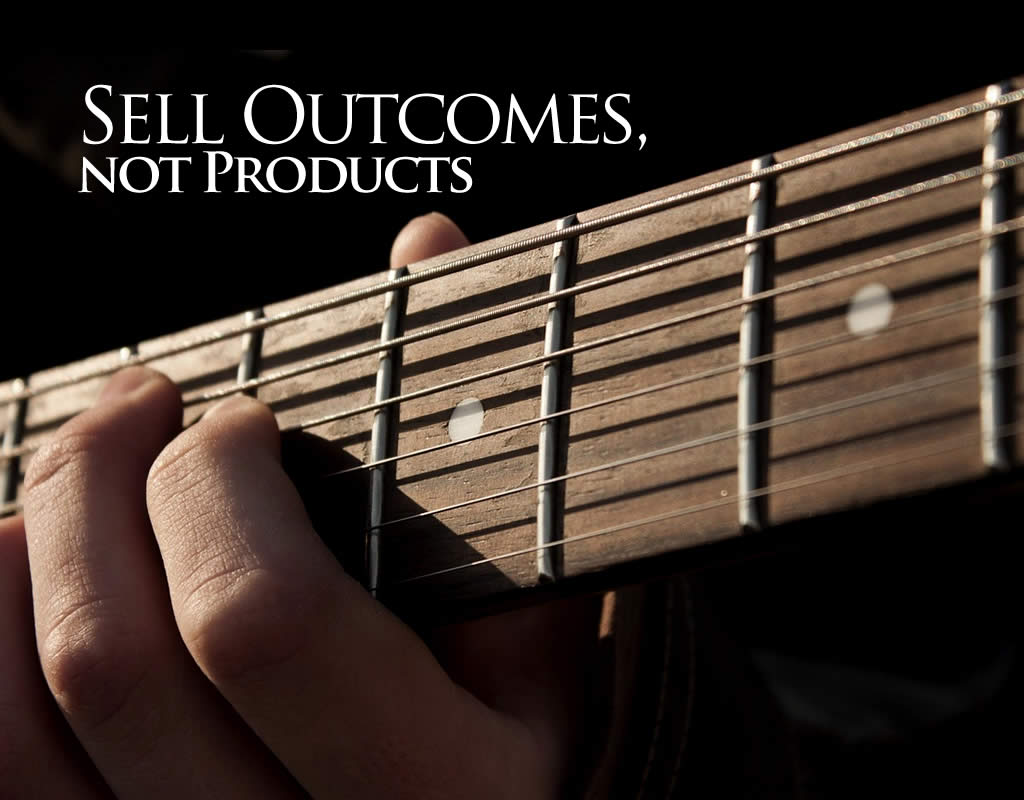Sell Outcomes, Not Products

 Sell outcomes. The products or services you exchange at the transaction stage of a business relationship might not be the most meaningful basis for describing what you offer. Before you print your next batch of business cards, think like a storyteller. All your competitors sell what you sell, but do they produce the same outcomes for customers?
Sell outcomes. The products or services you exchange at the transaction stage of a business relationship might not be the most meaningful basis for describing what you offer. Before you print your next batch of business cards, think like a storyteller. All your competitors sell what you sell, but do they produce the same outcomes for customers?
Most guitars are not sold because of their tone and playability; they’re sold because of the stories people tell about them. Some buy a guitar thinking about price and budget. Some think about how wonderful it will be to own an instrument built by their favorite, famous guitar-maker. Some want to play the same kind of guitar their favorite musician does. Others want a particular type or combination of woods or a certain style of construction.
I knew a guitar dealer who stocked fine instruments that had been hand-made by some of the best builders in the world. Some cost over $10,000. Customers would tell him they liked rosewood guitars, or hated maple guitars. Some didn’t like instruments built by so-and-so, or preferred big-bodied guitars. Richard would sit them down in his studio where they were surrounded by walls of beautiful instruments. “You are about to invest in a guitar that will be your creative voice for years to come” he’d explain. “This is like finding a life partner. My job is to help you find the one you’ll love forever. You may think you like blondes or prefer dates who wear smart-looking glasses, or that you hate tattoos or don’t like foreign accents, but true love is blind.” Then he’d pull out a long silk handkerchief and cover the customer’s eyes.
“Rarely did a client choose anything close to their stated preferences,” he told me. “Once we put all the builders and different kinds of wood on a level playing field—once we removed the brand bias from the selection process—the buyer would quickly narrow the field down to two or three choices. Usually, they were astonished that their favorite was an instrument they never would have chosen if they’d been allowed to select a guitar with their eyes.
“And some of them really did fall in love. If they found one instrument that inspired them more than all the others, they’d spend thousands more than they planned; they didn’t want to let that once-in-a-lifetime perfect-guitar-for-me get away. Some of them bought two or three!”
It’s only sensible to choose a musical instrument with your ears and your fingers. (For the same reason, musicians sit behind a curtain when they audition for symphony orchestras.) Richard probably thought of his blindfold as a simple way to help his customers make smart choices—but his powerful sales technique changed their stories. His clients’ concerns about brand name status and wood selection and price had little to do with the real, meaningful conflict in their authentic stories. Their deeper, authentic goal was musical fulfillment; their authentic conflict was lack of it. Each was looking for a special tool that was uniquely suited to helping them express their individual, musical voice—and that was the meaningful transformation Richard sold them.
Conflict, transformation, and authenticity are three of the four elements that make up a compelling story. So where’s the magic—the invisible force? The wind that drives the ship? Whether he knew it or not, Richard’s true product wasn’t musical instruments. What he sold was his magic—his special ability to help you find that one special instrument that would be your musical soulmate.

Change the conversation from features and price to benefits and value. Was Richard a guitar dealer or something much more? Storytellers sell outcomes, not products and services. Stories are about people, and people are whom outcomes are for. Look for the unique insights you offer that your customers benefit from, and if you’re lucky, you just might discover the magic you overlooked before you have your business cards printed.


